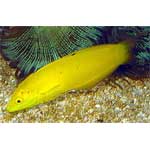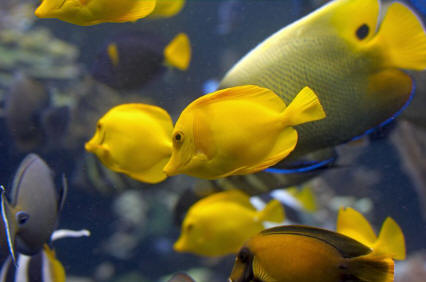Golden / Canary Wrasse

|
Scientific Name: Halichoeres chrysus Price: Upon Request Origin: Indo-Pacific Family: Labridae NOT AVAILABLE NOW |
Technical Info
Temperature: 22 - 26 ℃
pH: 8.1 - 8.4
GH: 8 - 12
SG: 1.020 - 1.025
Max size: 12 cm
Min Tank size: 120 Ltr
Position in Aqua: No special swimming level
Description
The Golden / Canary Wrasse is golden-yellow with a black eyespot on the dorsal fin. The tail fin is sometimes blue. An under-appreciated, brilliantly garbed wrasse that remains relatively small and readily acclimates to captivity. It can be kept in groups that provide color and interest to a peaceful marine community group.
Food
Carnivore-The Golden/Canary Wrasse is easy to feed and accepts most types of food, including marine flake food. Sometimes they need to be trained before accepting flakes. They should be provided a varied meaty diet. A good diet can be based around flake food that is complemented with frozen food and chopped sea food. Feed them 3 times a day.
Breeding
his species have not been bred in aquariums. In the wild, it breeds in harems where one male keeps several females. Perfect conditions and keeping them in a harem is likely required to breed them. Sexing the Yellow coris / wrasse is a bit harder than sexing other wrasses, but females are generally speaking smaller and less colorful. It is hermaphroditic and all (most) fish are born females and then develop into males if there is a shortage of males. Some fish – so called super males – are genetically determined to be males their entire lives.
Compatible with
This is normally a very mellow species that rarely, if ever, behaves aggressively toward tankmates. It is more likely to be the target of bullies (namely dottybacks, damselfishes, hawkfishes). You can keep more than one female in the same tank—keep males on their own or with one or more females. (Males have brighter orange bands on their heads and one rather than two spots on the dorsal fin.) This wrasse is not a threat to most ornamental invertebrates with the possible exception of shrimps.
Note
The Golden Wrasse is a bottom-oriented species that swims about searching the sand or rock surface for edibles. It will follow tankmates that disturb the sand in hopes of pouncing on prey items flushed from hiding by a substrate-disturbing species.

